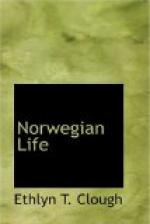Newspapers in Norway are not so good an investment; in fact, none of them may be considered financial ventures. As a rule, they have to be assisted by the government or by political clubs in order to survive. Their subscription lists are limited, the largest circulation in Norway not exceeding fifteen thousand and few publications print more than five thousand copies, while advertising pays not more than ten or twelve cents a line at top prices in the most expensive papers.
An ordinary newspaper reporter in Norway receives a salary of about $5 a week, while the most competent editors are satisfied with $20 or $25. Norway was the last of the European countries, except Turkey, to adopt the art of printing, notwithstanding its early famous literature, but to-day has four hundred and twenty-nine newspapers and periodicals, an average of one to every five thousand of the population; one hundred and ninety-six are political newspapers; eighty-eight are literary weeklies, and one hundred and forty-five are reviews, magazines, professional, religious, and scientific publications.
Norske Intelligens-Seddeler is one of the oldest papers in the world, having been founded in Christiania in 1763, and has been the organ of the government from the beginning. For a century and a quarter its contents were limited to advertisements and official announcements. It was a sort of a government gazette, but when Hjalmar Loken took hold of it, ten or twelve years ago, he changed its character entirely and has turned it into a good modern newspaper and a vigorous advocate of government measures, exercising a wide influence through its columns.
Monopolies were formerly granted to newspapers in Norway. The government allowed only one paper to be published within the limits of an ecclesiastical diocese, or at least only the favored paper was permitted to receive money for the publication of advertisements. Competitors resorted to all sorts of ingenious methods, by issuing pamphlets and ’handbills and such things, that a free discussion of political issues might be had, but it was not until 1786 that the last monopoly, which happened to be in the city of Trondhjem, expired. In 1814 freedom of the press was granted by the new constitution, and from that date the political agitators have found expression in various publications, and partisanship has often risen to a bitterness that would not be permitted in other countries. The Norway newspapers have not known a censor since that date.
Morganbladet, the first daily, was established in 1819, and has played an important part in the political affairs of the. country. It is still very influential, being edited with great ability by Mr. Nils Vogt. Bjoernson, the author, has been connected with two newspapers—the first, Krydseren, a literary weekly which survived only a few years, and Verdens Gang, which has been published since 1868 as the leading organ of the liberal party. Among its editors and contributors have been other distinguished men, poets, dramatists, and novelists. Nearly every writer of distinction has contributed to its columns, for most of the thinking men of Norway are liberals. Since 1878 Mr. Thommessen has been the editor, and he was the first to modernize the Norwegian press by printing cable dispatches, cartoons, caricatures and other illustrations.




